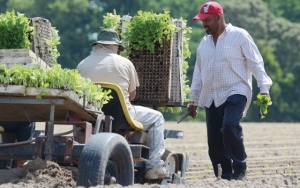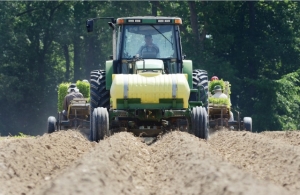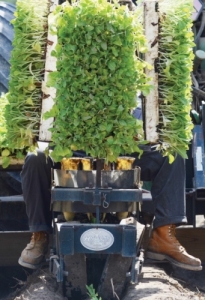Wayne farmers report tobacco plant shortage
By Steve Herring
Published in News on May 12, 2014 1:46 PM

News-Argus/CASEY MOZINGO
Juan Francisco Ramirez, right, follows behind the transplanter to make sure the young tobacco plants are inserted one plant to a hole as Gudardo Hernández, left, loads the plants into the machine Friday morning on a farm off Hinnant Road in Pikeville.

News-Argus/CASEY MOZINGO
Gerald Ballance drives a tractor pulling a transplanter on his farm off of Hinnant Road near Pikeville Friday morning. A tobacco shortage is threatening the profits of many Wayne County growers this season.
The heart of the tobacco belt is beating a bit uneasily these days as a shortage of tobacco plants is threatening to turn what had been an expected 2-3 percent increase in acreage in Wayne County to a loss of 100 acres or more of the golden leaf.
And calls to South Carolina and Georgia have failed to turn up any additional plants. Some local farmers are re-seeding their greenhouses in an attempt to help make up the shortfall. But this late in the season, those plants normally lack the quality and yield of the earlier ones.
While the shortage has put some farmers behind schedule, most farmers are primarily behind because of extremely wet conditions, especially in the northern parts of the county.
"If you look at the county as a whole, we are really in two different worlds," said Tyler Whaley, an Extension Service field crop agent. "What I mean by that is if you go to the southern and eastern ends of the county, we are pretty much on schedule in terms of setting out tobacco.
"But if you go to the northern and western ends, we are behind. We have some growers who finished up in the past couple of days in the eastern and southern ends. Then you go to the northern end, and they can't even get into the fields in places it is still so wet. So they are behind. They are probably a week behind, I guess."
The delay is not critical yet, but it is getting there, he said.
"It is just a matter of if we can get some drier days," Whaley said. "We have the equipment to handle setting out a lot of acres per day. It is just a matter of field conditions improving so that we can set tobacco."
Over the past year, the county has been in a pattern of continuous rain, but it still needs some, he said.
"If it were to suddenly stop, then we would experience hard, compacted soils that would not be favorable to growers," Whaley said. "So we need showers periodically to keep that from happening."
The plant shortage is "huge problem," Whaley said.
"That dates back to the beginning of the year," he said. "If you remember, we try to set greenhouses, we target the 15th of February. Usually it takes 60 quality days to go from seeding the greenhouse to setting out in the field. So we are looking from Feb. 15 to April 15 -- those 60 days. If you remember, the weather patterns back in February weren't favorable for greenhouse production.
"We had some guys seed greenhouses in the snow. They knew they would have to run their heaters to keep the snow off the plastic so they said they might as well seed. So dating back to that, we had a lot of germination issues just for the simple fact that the conditions were not favorable."
Those issues ultimately led to a decrease in usable plants.
"I say on average our plant stand is 5 to 10 percent less in useable plants than we would normally have," he said. "That is a big problem."
Whaley said he had spoken with North Carolina State University officials who had told him they had been unable to find any extra plants in South Carolina or Georgia.
"If you look at the county, we had a lot of growers that put up greenhouses this year," Whaley said. "So going in, I think as a whole we had more plants seeded, but when you factor in the 5 or 10 percent stand loss with the extra houses being put up, we are kind of at a wash, I think.
"I know that we are short, but we had a lot more seeded than what we usually have."
In January, Whaley was projecting a 2-3 percent increase in acreage, but now he doesn't know if there will be increase or not.
"We might be back where we were last year -- between 10,000 and 11,000 acres," he said.
Whaley said he doesn't know if some farmers are hanging onto plants just in case of another early wind storm. It would be bad to give away plants, then have storm damage and not have any extra, he said.
"I know right now I am looking at a hundred acres (short) in the county, but that is just people who have called me," Whaley said. "I know other people are looking for plants. Everybody is short. It is countywide, but that is just the 100 acres."
It is too early to say what the actual shortage could be, he said.
"We like to see tobacco transplanted by the 15 or 20th of May," Whaley said. "Once you get in the last week of May or the first week in June, in my opinion the quality of the tobacco and the yield goes down."
Some farmers have re-seeded greenhouses in an attempt to get more plants, but again the quality is in question, he said.
"But like I said, farmers will take a chance," he said.
Farmers do have some options.
"Well, one thing growers could do is reduce their plant populations," he said. "Typically we are shooting for a final plant population of 6,000 plants per acre. (N.C. State) University data show that you could reduce population levels by 500 plants and not see a yield reduction.
"Also, growers need to use Extension agents across the state to see if any additional plants can be found. Lastly, a few growers re-seeded greenhouses once they set out the first crop. Plants could be ready to set in 40 days after they were seeded. They are really pushing their luck doing this, but farmers are gamblers."

